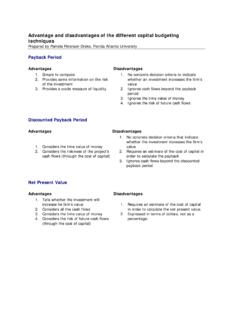Transcription of Estimating payback for energy efficiency - Energize Ohio
1 PM 2089S November 2011 Estimating payback for energy efficiencyFARM ENERGYMany farmers and agribusiness owners who are investing in new or re-furbished equipment want to know how quickly the returns from reduced energy costs will help the investment reach its break-even point. If only energy costs are considered, equipment with longer payback periods may not be economical until it nears the end of its useful life. When equipment must be replaced, consider a more complete cost analysis including initial investment, energy usage, equipment life, and mainte-nance costs. Saving money today by purchasing equipment with lower initial cost (and higher energy demands) puts the buyer at risk when energy prices rise in the future.
2 This can potentially negate the savings associated with a low purchase paybackThe payback period is typically calculated as simple payback : divide the initial cost of the energy -saving investment by the projected annual energy cost savings. For example, if new equipment costs $4,800 and the projected annual energy savings at current energy prices is $1,600, after three years (= $4,800/$1,600) the initial cost of the purchase has been repaid through energy savings. If annual maintenance costs increased, they would be subtracted from energy savings. ExamplesSpecific examples of potential energy savings and equipment costs are provided in several other Farm energy fact sheets from the PM 2089 series.
3 Short summary examples are given here to illustrate the truckThe existing farm truck has an estimated fuel efficiency of 15 mpg, but a late-model truck gets an estimated 25 mpg and is available for $15,000 plus trade-in. Assuming 18,000 annual mileage, the newer truck would consume 720 gallons (= 18,000/25) of fuel versus 1,200 gallons (= 18,000/15) for the existing truck. At fuel prices of $ per gallon, the extra 480 gallons of fuel conserved equals $1,440 annually. The simple payback period is years (= $15,000/$1,440). However, at increased fuel costs of $ per gallon, the simple payback is years (=$15,000/$1920).
4 Both trucks also will incur annual maintenance costs, but these costs are lower for the newer truck and it will also have a higher salvage value than its hp electric motor A 10 hp electric motor is being used 10 hours per week to grind feed. A new replacement motor is estimated to save one kWh of energy during each hour of operation, saving 10 kWh each week or 520 kWh annually. Assuming electricity costs $ per kWh, the annual cost savings is $52. If replacement cost for a 10 hp motor is $1,000 on average, the simple payback is years (= $1,000/$52). Therefore, if economics are the only factor considered, replacement would most likely be delayed until the end of the motor s useful life.
5 SummaryWhen examining return on investment, consider the total cost of energy , useful life, availability of newer technology, etc. Replacing a well-functioning piece of equipment that is seldom used is nearly impossible to justify when considering only energy savings. Replacement of well-functioning, high-usage equipment is more practical, but all costs should be considered. Just because something is more energy efficient does not mean that replacement is a wise investment.. and justice for all The Department of Agriculture (USDA) prohibits discrimination in all its programs and activities on the basis of race, color, national origin, age, disability, and where applicable, sex, marital status, familial status, parental status, religion, sexual orientation, genetic information, political beliefs, reprisal, or because all or part of an individual s income is derived from any public assistance program.
6 (Not all prohibited bases apply to all programs.) Persons with disabilities who require alternative means for communication of program information (Braille, large print, audiotape, etc.) should contact USDA s TARGET Center at 202-720-2600 (voice and TDD). To file a complaint of discrimination, write to USDA, Director, Office of Civil Rights, 1400 Independence Avenue SW, Washington, DC 20250-9410, or call 800-795-3272 (voice) or 202-720-6382 (TDD). USDA is an equal opportunity provider and employer. Issued in furtherance of Cooperative Extension work, Acts of May 8 and June 30, 1914 in cooperation with the Department of Agriculture.
7 Cathann A. Kress, director, Cooperative Extension Service, Iowa State University of Science and Technology, Ames, by Mark Hanna, extension ag engineer; Jay Harmon, professor, ag and biosystems engineering; and Dana Petersen, program coordinator, ISU Farm energy ; Iowa State University Extension. Sponsored by the Iowa energy Initial cost to replace bulbs in a livestock facility is $400, but projected annual electrical energy savings is $2,000. The simple payback period is years (= $400/$2,000) with a savings of $1,600 in year one and $2,000 in year two. Estimated bulb life for the project is two years, so return on investment is $3,600 over two years.
8 Extra labor costs may be incurred to make the switch to new lightbulbs or fixtures, but consider if the energy savings from the upgraded, energy efficient lighting will cover labor and installation lifeDetermining the useful life of farm equipment is a combination of how long the equipment remains functional with reasonable repair costs and the availability of replacement equipment that is more energy efficient or more technologically advanced. A component with limited annual hours, such as an infrequently used motor, is unlikely to be replaced solely to conserve energy , due to its replace-ment cost and limited use.
9 Comparing energy projects with different useful lifetimesWhen comparing energy -savings investments it is important to note the relative payback period versus annual energy savings and estimated useful life. In Table 1, the initial cost and annual savings for projects A and B result in the same simple payback of three years. However, equipment for project B has a useful life of eight years. Equipment for project A lasts only four years. Even though both projects have the same simple payback , project B has a greater economic advantage over project A since the equipment in B continues to generate additional savings over a longer time.
10 Project C, with a similar life span as project B (eight years), requires an initial cost of $1,200 and generates energy savings of $800. Simple payback for C, at years, is twice as fast as project B. However, the greater annual energy savings of project B results in more total money saved after five years and possibly longer, if the equipment remains useful. These examples show the limitations of using simple payback to compare projects where the useful lives or annual projected energy savings of the equipment are considerably different. Table 1. Comparisons of projects with different useful lives and annual energy cost$4,800$4,800$1,200 Annual savings1,6001,600800 Simple payback3 yr3 yrUseful equipment life4 yr8 yr8 yrCost (-) or savings (+) at the end of year:1-3,200-3,200-4002-1,600-1,60040030 01,20041,6001,6002,0005-1,6003,2002,8006 04,8003,60071,6006,4004,40083,2008,0005, 200 Time-value of moneyBecause of gradually increasing inflation, future dollars aren t worth quite as much as present dollars spent on equipment.









